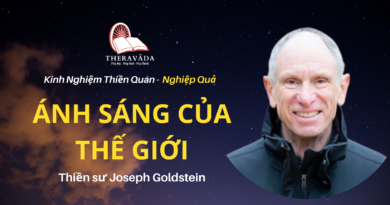VIPASSANA MEDITATION – CHAPTER 4: THE FOUR FOUNDATIONS OF MINDFULNESS
MAIN CONTENT
VIPASSANA MEDITATION – CHAPTER 4: THE FOUR FOUNDATIONS OF MINDFULNESS
When the Buddha had explained the seven benefits of mindfulness, he continued to explain the Four Foundations of Mindfulness:
- Kayanupassana Satipatthana
- Vedananupassana Satipatthana
- Cittanupassana Satipatthana
- Dhammanupassana Satipatthana
Kayanupassana Satipatthana means contemplation of the body or mindfulness of any bodily process as it occurs. Vedananupassana Satipatthana means contemplation of feeling or sensation. This feeling or sensation is of three types:
- Pleasant feeling or sensation,
- Unpleasant feeling or sensation,
- Neutral feeling or sensation.
Pleasant feeling or pleasant sensation is called sukha vedana (sukha means pleasant, vedana is feeling or sensation). Unpleasant sensation or unpleasant feeling is called dukkha vedana in Pali (dukkha here means unpleasant). Neutral feeling or neutral sensation is called upekkha vedana (upekkha means neutral – neither pleasant nor unpleasant). When pleasant feeling, unpleasant feeling or neutral feeling arises, a meditator must be mindful of it as it is. Some meditators think that unpleasant feeling should not be observed because it is unpleasant. Actually, all kinds of feeling must be noted very attentively as they really occur. If we do not observe or note the pleasant or unpleasant feeling or sensation, we are sure to become attached to it or repulsed by it. When we like a particular feeling or sensation, we become attached to it. That attachment or tanha arises depending on the feeling or sensation. In this case, the pleasant feeling is the cause and attachment is the effect.
If a meditator practises strenuously and perseveringly, his concentration will become deep and strong. When the meditators concentration becomes deep and strong, he feels happy and experiences rapture because his mind is, at that moment, quite free from all defilements such as greed, hatred, delusion, conceit and so on. The persevering meditator has attained a very good stage of insight because his mind is now calm, tranquil and serene. If the meditator enjoys it and is satisfied with what he is experiencing, it means he is attached to it, and thus he cannot progress to the higher stages of insight. Such an experience can be attained in the first part of the fourth stage of insight. If he understands that, he should just observe the experience he has attained at this stage. Whatever he is experiencing at this stage, he will not become attached to it if he observes his experience very attentively and energetically. When the meditator notes it attentively and persistently, that happiness, tranquility or serenity will not be manifested in his mind very distinctly.
What he realises at that moment is just feeling that arises and passes away. Then another feeling arises and passes away. He cannot differentiate between pleasant and unpleasant feelings, thereby, he becomes detached from his experience and proceeds to practise for a higher stage of insight. Only then can he go beyond this stage of insight.
If a meditator walks very mindfully, noting the six parts of the step: lifting of the foot, raising of the toes, pushing the foot forward, dropping it down, touching, and pressing, and as a result, his concentration is good, deep and strong, he will not be aware of the form of the foot. Nor is he aware of the body or bodily form. What he knows is just movement of the foot. The movement may also feel light; he may feel as if he is walking in the air. He may feel as if he is lifted in the sky. At this stage, he is experiencing excellent meditation experiences. If he does not observe these experiences mindfully, he will like them and may desire more of them. He may become very satisfied with his practice and he may think this is nibbana (the cessation of all kinds of suffering) because this is the best experience he has ever had. All this happens because he does not observe his pleasant experiences, and so is attached to them. This attachment arises depending on the pleasant feeling or pleasant sensation about his good experience.
If a meditator enjoys this pleasant feeling or sensation about his good experience without being mindful of it he is sure to become attached to it. So, he should observe and be aware and mindful of whatever experience he has encountered at this stage. He must not analyse it or think about it, but must be aware of the experience as it really occurs, in order to realise that this experience of the mental process or mental state is subject to impermanence. Whenever he notes, he finds that the experience is not everlasting. When the noting mind becomes constant, sustained and powerful, it penetrates into the nature of his experience, i.e. the mental state. The mind begins to realise that the experience has disappeared. Whenever it arises, the mind notes it, and again it disappears. He then concludes that this pleasant feeling together with his experience is impermanent (anicca), because he has comprehended the nature of impermanence through his personal experience of the Dhamma. Here, Dhamma means mental as well as physical processes. Because he has realised that the pleasant feeling or sensation together with the good experience is impermanent, he will not be attached to it. Attachment will not arise when the meditator rightly understands the true nature of good mental states or a good experience.
Part 1 – Chain Of Cause And Effect
When attachment does not arise, grasping or upadana will not arise. When grasping does not arise, there will not be any wholesome or unwholesome actions, verbal, physical or mental. The action that is caused by grasping is known as kamma bhava. This may be wholesome or unwholesome. Wholesome bodily action is kusala kaya kamma. Unwholesome bodily action is akusala kaya kamma. Wholesome verbal action is kusala vaci kamma. Unwholesome verbal action akusala vaci kamma. Wholesome mental action is kusala mano kamma. Unwholesome mental action is akusala mano kamma. These actions or kamma arise through the grasping which is the result of attachment to pleasant or unpleasant feeling or sensation.
When any bodily, verbal or mental action is carried out, it becomes a cause. This cause has its result which may occur in this life, or future lives. So in this way, a being is reborn again through his wholesome or unwholesome action. That action is caused by the grasping which has attachment as its root. Attachment, in turn, is conditioned through reeling or sensation, vedana In this way, a being has to be reborn in the next existence to experience a variety of suffering because he does not observe his pleasant feelings together with his experience.
Therefore, if a meditator thinks that feelings should not be observed, he will be carried away along the Chain of Dependent Origination (paticcasamuppada) to be reborn in the next existence and suffer from a variety of dukkha. That is why the Buddha teaches us to be mindful of any kind of feeling or sensation whether pleasant, unpleasant or neutral.
Part 2 – Mindfulness Of Feeling
Mindfulness of sensation or contemplation of sensation is known as Vedananupassana Satipatthana. Usually at the beginning of the practice, the meditator feels the unpleasant physical sensations as well as mental sensations. Here we need to explain again the two kinds of sensation:
- Kayika vedana
- Cetasika vedana
If the feeling or sensation arises depending on physical processes, it is known as Kayika vedana We may translate it as physical feeling or sensation, or bodily feeling or sensation. If the reeling or sensation arises depending on mental processes, it is called cetasika vedana. We may render it as mental feeling or mental sensation. Actually, every feeling, every sensation is a mental process, not a physical process. However, sometimes feeling or sensation arises depending on the physical process of discomfort. When a meditator feels discomfort in his body, then unpleasant sensation arises. That unpleasant sensation is called k_yika vedan_ because it arises depending on physical processes.
In the beginning of the practice, a meditator generally experiences mostly unpleasant mental and physical sensations. But whatever sensation he may experience, he must observe it very attentively, energetically and precisely so that he can realise the true nature of that feeling or sensation. The specific and the general characteristics or the reeling must be thoroughly realised so that he will not be attached to it or repulsed by it. This is Vedananupassana Satipatthana – mindfulness of feelings or sensations. Whenever feeling arises, it must be observed and noted as it really occurs.
It is natural for a meditator to be afraid of unpleasant physical sensation which he experiences in his meditation practice, but painful sensation is not a process that should be feared. Pain is a natural process that should be thoroughly understood by being aware of it as it really occurs. When a meditator can observe pain successfully with persistent effort, then he can realise its true nature – the specific and general nature of pain. Then the penetrating insight into the true nature of that pain or unpleasant sensation will lead the meditator to the higher stages of insight. Eventually, he could attain enlightenment by means of this painful sensation.
Part 3 – Mindfulness Of Consciousness
The third Foundation of Mindfulness is Cittanupassana Satipatthana which means mindfulness of consciousness and the states (cetasika) that arises with consciousness.
According to the Abhidhamma, every mind, so to say, is composed of consciousness and its concomitants. Concomitants here means its associates. Consciousness never arises independently. It arises together with its associates. In short, whatever consciousness or whatever mind or mental state arises, must be mindfully noted or observed as it really occurs. This is Cittanupassana Satipatthana. The mental states may be good, the emotional states may be better. Whatever it may be, it must be noted as it really occurs. Therefore, when you have consciousness with lust or attachment, you must be mindful of it as it really is. If you have consciousness with anger, you must note it as consciousness with anger.
Consciousness with anger can be noted as angry or anger in accordance with the Maha Satipatthana Sutta. When mindfulness is powerful, the anger will disappear. The meditator will then realise that anger is not everlasting – it arises and passes away. By observing anger, a meditator has two kinds of benefit:
- The overcoming of anger.
- Realisation of the true nature of anger (the arising and passing away of anger or the anicca nature of anger).
Anger is one of the mental states that can lead the meditator to the cessation of suffering if he notes it with mindfulness.
Part 4 – Mindfulness Of Dhamma
The fourth Foundation of Mindfulness is Dhammanupassana Satipatthana which means contemplation of dhamma or mindfulness of dhamma. Here dhamma includes many categories of mental or physical processes. The first category is the five nivarana (hindrances):
- Kamacchanda. Sense desire – desire for visible objects, sounds, odours, tastes and tangible objects.
- Vyapada. Anger or ill will.
- Thina middha. Sloth and torpor – sleepiness, mental dullness, heaviness.
- Uddhacca kukkucca. Remorse, worry or unhappiness about past deeds. Unhappiness at the failure to do what should have been done in the past is the first aspect. The second aspect is unhappiness about a deed which you did though you should not have done it, i.e., an unwholesome deed which would produce a bad result.
- Vicikiccha. Doubts.
So long as the mind is defiled, a meditator cannot realise any mental process or physical process. Only when the mind is well concentrated on the object of meditation (either mental or physical processes), is it free from all kinds of defilements or hindrances. Thus the mind becomes clear and penetrative; so penetrative that it realises the true nature of mental and physical processes as they really are. So whenever any one of the five hindrances arises in a meditators mind, he must be aware of it. For example, when a meditator hears a sweet song from outside and does not note it, he may have a desire to listen to the song. He likes to hear this song repeatedly and he indulges in it. That desire to listen to the song is sense desire – kamacchanda. So, when he hears any sweet song, he must note hearing, hearing.
Still, he may be overwhelmed by the song if his mindfulness is not powerful enough. If he knows that this sense desire for the song can lead him to undesirable events or accidents, or can be an obstacle to his progress in meditation, he will note it as desire, desire until it has been destroyed by strong mindfulness. When the mindfulness becomes constant and strong, that desire will disappear. The desire disappears because it has been observed very attentively and energetically. When a meditator observes or is mindful of his sense desire as it really is, making a mental note, desire, desire, he is following strictly what the Buddha taught in the Maha Satipatthana Sutta. Being mindful in this manner is Dhammanupassana Satipatthana or the contemplation of mind objects, i.e. contemplation of the hindrances (nivaranas).
Thina middha, sloth and torpor, actually means sleepiness. Sloth and torpor is a very old friend of meditators. When a meditator feels sleepy, he enjoys it. If any other pleasant sensation arises in him, he is able to observe it. But when sleepiness arises in him, he is unable to be aware of it because he likes it. That is why sloth and torpor or sleepiness is an old friend of a meditator. It makes him stay longer in the cycle of rebirth. If he is unable to observe sleepiness, he cannot overcome it. Unless he has realised the true nature of sloth and torpor or sleepiness, he will be attached to it and enjoy it.
When we are sleepy, we should make more strenuous effort in our practice; that means we must observe more attentively, energetically and precisely so that we can make our mind more active and alert. When the mind becomes active and alert, it will be free from sleepiness. Then the meditator can overcome sleepiness.
Uddhacca kukucca is the fourth of the hindrances. Uddhacca is restlessness or distraction, kukucca is remorse. Here uddhacca means distraction of the mind, restlessness of the mind, wandering of the mind. When the mind wanders or thinks about something else instead of noting the object of meditation, it is uddhacca. When your mind wanders, you must be aware of it as it really is. At the beginning of the practice a meditator may not be able to observe it. He does not even know that the mind is wandering. He thinks the mind is staying with the object of meditation, i.e. the abdominal movements or respiration. When he is aware that the mind has wandered, he must note wandering, wandering or thinking. thinking. That means uddhacca kukkucca is observed.
The fifth hindrance is vicikiccha or doubt. You may have doubt about the Buddhathe Dhamma, the Sangha, or about the technique of meditation. Whatever doubt arises, it must be very attentively observed, you must be mindful of it as it really is. This is known as Dhammanupassana Satipatthana – mindfulness of dhamma. So these are the four Foundations of Mindfulness:
- Kayanupassana Satipatthana- contemplation of the body or physical phenomena.
- Vedananupassana Satipatthana – contemplation of feeling or sensation.
- Cittanupassana Satipatthana – contemplation of consciousness together with its concomitants or associates.
- Dhammanupassana Satipatthana – contemplation of dhamma or mind objects.









